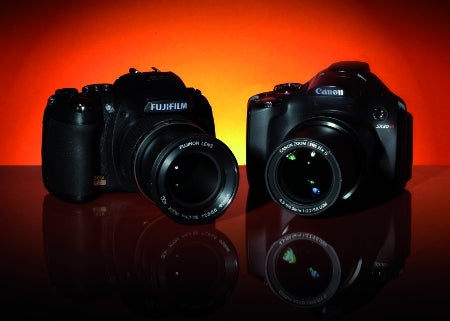The Canon SX30 and the Fujifilm Finepix HS10 scored the same overall when tested individually. But when compared head-to-head, did one come out on top?
Canon SX30 IS vs Fujifilm Finepix HS10
The big draw for superzoom cameras such as the Canon SX30 IS
and Fujifilm HS10 is that they offer the convenience of a huge focal range
within a relatively small body.
While image quality is never going to be able to match that
of a quality DSLR and lens combination, there’s no need to lug a camera bag
full of lenses around or swap lenses in dusty conditions. And given that the
focal range of each model stretches from a wide angle 24mm to well over 700mm,
they are also a considerably cheaper approach too.
Both cameras have already received standalone reviews in
WDC, and both received a respectable overall score of 88%. But when tested side
by side, which one comes out on top? Let’s take a closer look at each and find
out…
Features
Although somewhat similar on the surface, both cameras are
different on the inside, starting with the sensors: Although both cameras use a
1/2.3in sized sensor, the Canon SX30 IS employs a 14.1MP CMOS, while the Fujifilm HS10 uses a newly developed 10MP BSI (Back Side Illuminated) CMOS sensor.
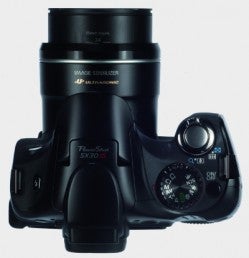
Image: Canon SX30 IS
This effectively flips the sensor round so that the wiring layer sits on the
underside with the photodiodes exposed directly to light entering from the
lens. Both cameras contain proprietary image processors. The DIGIC 4 processor
found in the Canon is well established as a solid performer in other Canon
cameras, and while the processor in the HS10 lacks a specific name, Fuji claims it has been specially
developed to work with the BSI CMOS sensor.
In keeping with their superzoom
credentials both cameras offer impressive focal ranges. In the case of the 35x
Canon this extends from 24-840mm in 35mm (full-frame) terms, while the Fuji
isn’t far behind with a 24-720mm range. At the wideangle end this is plenty enough
to capture landscapes and large groups of people, while at the telephoto end both
cameras are capable of fi lling the frame with a subject some considerable
distance away. In addition, each camera offers a Macro mode with the minimum
focus distance from the Canon SX30 IS so impressive that the subject can more or less
touch the lens.
Image: Fujifilm HS10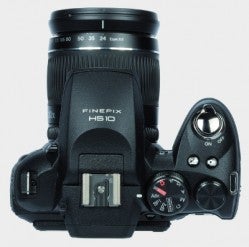
Both cameras feature a wide range of shooting modes,
including Automatic, Aperture priority, Shutter priority and full Manual
control for more advanced photographers. Novices are well catered for too, with
each camera offering a good variety of scene modes.
In the movie-recording department both cameras are able to
record HD video at 30fps, although the SX30 IS is limited to 720p HD while the
HS10 records 1080p Full HD. Both cameras also record stereo sound via dual
microphones positioned either side of the lens, although neither offers a
socket for an external microphone.
Both models feature articulated LCD screens to
assist with shooting from extreme angles, however the designs differ, as do the
screen sizes and resolutions. In the case of the HS10 the 3in, 230k-dot screen
folds out by 45° downwards and 90° upwards. 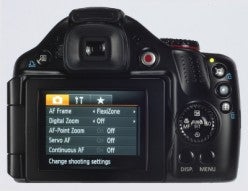
Image: Canon SX30 IS
The 2.7in, 230k-dot LCD fitted to
the SX30 IS, meanwhile, is of the swivel and tilt variety, which means it could
be used around corners and for self-portraits as well as high or low-angles.
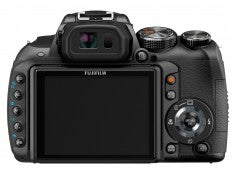
In
addition, the LCD screen can be reversed and folded back into the body for
added protection when not in use. In addition to LCD screen both cameras also
offer an Electronic Viewfinder (EVF), with the HS10 featuring an eye sensor
that automatically switches it on when the camera is raised to the eye.
Image: Fujifilm HS10
Design:
While neither camera is particularly small, the Canon is
easily the more diminutive of the two. Both are styled like DSLRs, and both
offer a relatively substantial finger grip. The weight difference between the
two is indiscernible in use, although the SX30 IS is a touch lighter when the
two cameras are placed on scales. With both cameras offering such large focal
ranges, close control of the zoom is a critical factor and here the manual
operation of the HS10 has a clear advantage over the mechanically powered zoom
of the SX30 IS.

Being able to manually rotate the HS10’s lens, as you would
on a standard DSLR lens, enables quick, precise and controlled framing, whereas
the spring-loaded wideangle/telephoto switch located in front of the shutter
button on the SX30 IS is relatively fiddly and time consuming to achieve
perfect framing with. With its manually operated zoom the HS10 does require two
hands to operate though, unlike the SX30 IS, which can be used singlehandedly if
absolutely necessary.
The HS10 also comes out on top for button placement and menu
navigation, with the angled top-plate-mounted adjustment dial and standalone
ISO/AE/AF/ISO/WB buttons along the back providing far quicker access to key
settings and shooting parameters than the d-pad and fly wheel navigation system
employed by the SX30 IS.
One further notable difference between the two cameras is in
the power source. While the SX30 IS relies on a supplied li-ion battery and charger,
the HS10 requires 4x AA batteries.
There are merits to both approaches, although it should be
noted that using cheap batteries with the HS10 is a false economy and a decent set
of rechargeables will incur some extra cost as well as the camera price itself.
Performance
Used side-by-side the relative strengths and weaknesses of
each camera become markedly apparent. The overall feel of any camera in the
hand is subjective to a great extent, but we found that the Fuji felt more secure in the hand, thanks to
its deeper grip and texturised rubber coating. And while the SX30 IS is also easy
to hold and use, its design does mean it’s a bit too easy to inadvertently
press the buttons located on the top right-hand side of the back of the camera
in use. This includes the Zoom Framing Assist button, which leads to your frame irritatingly zooming out in midcomposure until
you release it.
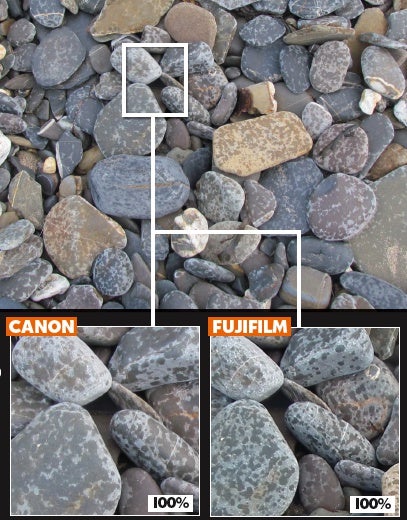
Detail:Viewed at 100%, edge sharpness is slightly higher for the
HS10 than the SX30 IS, although the effects of processing have also led to a
reduction in detail for both cameras – even at lower ISO settings. Given the
huge demands placed on each camera’s lens it’s not wholly surprising to find
that both cameras also suffer from chromatic aberrations in the form of purple
fringing.HS10: 1/45sec @ f/3.2, 60mm, ISO 100, AWB. SX30 IS: 1/30sec @ f/3.5, 67mm, ISO 100, AWB
Autofocus on both cameras is via the contrast-detection
method that is standard on compacts and the vast majority of non-DSLR digital
cameras. Both cameras performed admirably well in bright daylight, with no discernible
difference in speed between the two.
However, in darker conditions both cameras
can suffer from focus hunting and take longer to latch on to their target – a commonplace
problem for cameras using a contrast-detect AF system. The HS10 also boasts the
option of manual focus via a secondary ring on the lens barrel and a magnified
box in the centre of the LCD/EVF, although sadly it’s a bit fi ddly to use
given the resolution of the LCD and EVF.
Each camera features image stabilisation technology that
works well to keep images sharp even when the cameras are handheld and used at
their full telephoto reach. The SX30 IS benefi ts from a lens-based system that
provides up to 4.5 stops of compensation and is far superior at the longer
telephoto lengths as it has real-time effect on composition.

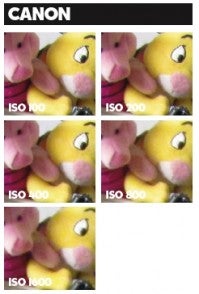
In brightly lit
daylight conditions this enables sharp images to be produced at the upper
reaches of the telephoto range even while using the camera handheld. The HS10, meanwhile,
combines mechanical sensor-shift stabilisation and ISO based stabilisation to
give effective results, though it’s in the results that you see the benefi t,
not during composition. Both cameras proved very adept at allowing relatively
slow shutter speeds to be used without denigrating overall image sharpness.
Very much marketed as a high-speed shooter, the HS10 is also
able to shoot at a maximum burst rate of 10 frames per second (fps), although
in practice it can only manage seven JPEGs before the buffer kicks in and shooting
grinds to a halt. The SX30 IS, by contrast, isn’t built with speed in mind and,
as such, can only manage about 2fps. If sports photography and the ability to
capture multiple images of fast-moving subjects ranks high on your list of
priorities, then the HS10 is the clear winner here.
The quality of HD movie capture from both cameras is very
good, with each able to produce pleasingly detailed, colour-rich results. Both
cameras offer continual autofocus, with the SX30 IS just shading the HS10 in
terms of AF speed.
The Ultra Sonic Motor of the Canon SX30 IS is also particularly
impressive, allowing for noise-free zooming, even while recording in the
quietest locations. This motorised zoom also allows for a smoother transition
from wideangle to telephoto (or vice versa). In contrast, the manual control of
the HS10 zoom makes in-movie zooming somewhat clunkier, while the stereo
microphones positioned just above the lens can also pick up some operational
noise as you manually rotate the lens.
In addition to regular HD movie recording, the HS10 can record
high-speed movies at various speeds up to a maximum 1,000fps. This does come at
the cost of resolution though, with 1,000fps movies reduced to an almost unwatchable
224 x 64 pixels with considerable compression. At 240fps though, resolution is
scaled up to a more YouTube-friendly and usable 442 x 332 pixels. While the
SX30 IS offers a smaller LCD screen (and viewable EVF area) than the HS10, we
found it much more pleasant to work with than the Fuji.
The SX30 IS’s screen is far brighter,
crisper and offers significantly better colour reproduction than the HS10. In fact,
the LCD is perhaps the HS10’s greatest failing. The viewfinders for both
cameras fail to be particularly easy to work with (at least compared to a DSLR
viewfinder), although again the smaller but infinitely crisper and more colour-rich EVF of the SX30 IS trumps the larger but
stuttering and washed-out view provided by the HS10’s EVF.
One final noteworthy
point that will be of importance to more advanced photographers is that, while
the HS10 can record still images as either Raw or JPEG files, the SX30 IS can
only produce JPEG files. While it’s still possible to post-process JPEG files
using dedicated software, the compression process that’s inherent in this means
that there isn’t as much information for the editing software to work with,
thus making the fi les less receptive to complex manipulation.
Image Quality
Tone & Exposure
Set to matrix metering both cameras display a marked
difference, with the Fujifilm HS10 tending to slightly underexpose and the Canon SX30 IS
slightly overexposing. In high contrast or bright conditions the former is
nearly always preferable as it’s easier to lift shadows in post-production than
it is to reclaim blown highlights. At lower ISO settings both cameras produce
good tonal ranges, although this does suffer as you increase sensitivity.
Colour & White Balance

Both cameras produce richly coloured images, although the
SX30 IS has the edge in terms of punch and vibrancy. It’s also possible to see
how the HS10 tends towards underexposure and notably darker images. HS10: 1/100sec @ f/3.6, 105mm, ISO 800, AWB. SX30 IS: 1/60sec @ f/4, 119mm, ISO 800, AWB.
Straight out of the camera and used on a standard setting,
colour is slightly more vibrant and punchier on the SX30 IS. That’s not to say that
colour on the HS10 is particularly muted, although it does lack the immediacy
of the SX30 IS. Used on the AWB setting, both cameras proved to be, for the
most part, reliable and accurate. That said, on some occasions the Fujifilm HS10 can err
towards producing slightly cold images while the Canon SX30 IS tends to go the other
way making images appear a bit warmer than they should be. There is some leeway
to fix these issues with post-production software though.
Sharpness and Detail
While the HS10 produces impressively sharp JPEGs with good detail
– even at 100% – we were somewhat less impressed with the SX30 IS. While the
majority of images came out acceptably sharp, there were also many that didn’t.
Given that some of these non-keepers were shot at a high enough combination of
shutter speed and aperture, and at a medium focal length, this was a bit
disappointing. Both cameras also suffer from noticeable chromatic aberration,
especially in high-contrast scenes, although given the demands of packing such
a large focal range into such small lenses this is understandable.
Value
Both cameras have fallen in price since their launch. The
Fujifilm HS10 can now be picked up for under £300, whereas the Canon SX30 IS generally costs
around £90 more. Not only does this make the Fujifilm HS10 the more attractively priced camera
of the two, but also puts the Canon SX30 IS into direct competition with some
entry-level DSLRs, including Canon’s very own 1000D.
Verdict
On paper the Canon SX30 IS – with its extra 5x zoom and
higher resolution – may seem like the better option. However, in real-world use,
the difference between 720mm and 840mm is less significant than you’d expect. And,
as is now recognised by consumers, sensor resolution is not the be-all and
end-all of image quality. Indeed high pixel counts can sometimes be detrimental
to image quality, though this doesn’t apply to the Canon SX30 IS.
Overall, choosing a winner between these cameras depends on
your priorities and tastes. In addition to its longer zoom and higher resolution
the Canon is smaller, has a better LCD screen, and better image stabilisation. But
while the Canon feels like a souped-up compact in use, the Fujifilm HS10’s
strengths may be the more appealing for enthusiasts seeking a more DSLR-like
experience. The manual zoom is more satisfying to use than the Canon’s twitchy
powered zoom control, and of course it offers the ability to record Raw files.
It also wins in terms of burst speed and ‘fun’ features such as Motion
Panorama. All in all neither model is completely perfect, particularly in the
viewfinder department, but overall the Fujifilm HS10’s more serious aspirations make it
our preferred choice. Just.
To see the full reviews and full specs of both cameras click here for the Canon SX30 IS and here for the Fujifilm HS10.
Alternatives to Consider
Panasonic FZ38 – £230
While the focal length only extends to 480mm, the 12MP FZ38 remains a quality performer.
Pentax X90 – £200
With a 26x zoom offering 26-676mm, the 12MP X90 could be a good budget option.
Nikon P100 – £265
Some image quality issues, but easy to use and well specified.





